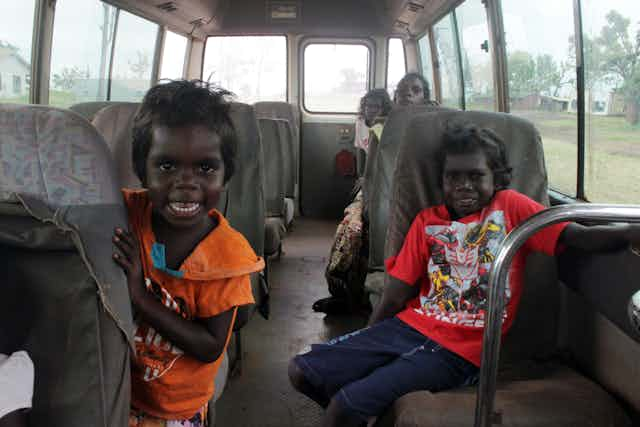Prime Minister Malcolm Turnbull presented the ninth annual Closing the Gap report to parliament this week. In keeping with previous reports, it outlined limited progress on key indicators of Indigenous disadvantage established by the Council of Australian Governments (COAG) in 2008.
These are measured in terms of a “gap” between Indigenous and non-Indigenous Australians across priority areas of health, education and employment.
This year’s report is important because four of the seven targets (child mortality, school attendance, employment outcomes, and reading, writing and numeracy) were set to be achieved by 2018. With the target of having all Indigenous four-year-olds in remote communities accessing early childhood education by 2013 already missed, key government actors will be concentrating on the real prospect of further failures in 2018.
There is no established format for the Closing the Gap report. Each successive report has presented its own narrative of Indigenous affairs, reflecting the priorities of the government of the day.
This year’s is twice the length of the 2016 report, and three times longer than Abbott’s 36-pager in 2015. The latest one presents more useful analysis and information about the data sources, and differentiates performance across regions and jurisdictions.
Turnbull’s emphasised narrative is one of “local solutions”, “empowerment” and “ambitious reform”. He promises to “overhaul” the operation of Indigenous affairs. He repeats the advice from Indigenous educator Chris Sarra that governments should “do things with us, not to us”. Yet Turnbull’s vision is being tested in practice.
Negatives, but also positives
The data themselves are grim. Only one of the seven targets - the rate of attaining year 12 schooling - remains on track to be achieved.
The headline target of closing the gap in life expectancy within a generation has not moved at all. Improvements in Indigenous health outcomes have been outpaced by improvements in the health of non-Indigenous Australians. The earlier improvements in child mortality rates have tailed off, indicating that the goal of halving the gap by 2018 will be harder to achieve than hoped.
The gap in the employment rate has worsened, and literacy and numeracy results for school children have remained inconsistent across age cohorts and jurisdictions. Former Prime Minister Tony Abbott’s additional target focussing on school attendance rates has not improved at all since 2014.
In all cases, remote communities fare worst. This is particularly the case in education and employment rates, but preschool attendance and antenatal care are also not accessed at optimum levels in urban and regional centres.
It is easy to focus on the negatives of missed targets and limited progress, but it should be remembered that Indigenous affairs is an area of enormous complexity and diversity. Significant improvements have also been made over time, as Turnbull said:
If we look at the long-term intergenerational trends, we see that Indigenous life expectancy is increasing, babies are being born healthier, more people are studying and gaining post-school qualifications and those adults are participating in work. These are achievements that families, elders and communities can be proud of.
The report also points to particular successes in specific policies. These include efforts to train community workers to prepare for the roll out of the National Disability Insurance Scheme, a substantial drop in tobacco smoking rates and the high take-up of Medicare health assessments.
Failures in Indigenous consultation
The annual reporting exercise is losing its salience as an exercise in accountability. The statement is noticeably partisan, focusing on the government’s own policies and failing to acknowledge genuine differences of opinion on key issues such as constitutional recognition, income management and cashless welfare, and township leasing.
The government’s own well-publicised failures, such as the chaotic roll-out of the Indigenous Advancement Strategy (IAS) as a key source of funding for Indigenous-specific services, are not mentioned at all. Nor is the harmful impact of the punitive work-for-the-dole Community Development Programme in remote communities.
The government’s reluctance to include measures of issues of particular concern to Indigenous communities, such as incarceration rates and family violence, is also disappointing.
There is little acknowledgement of the National Congress of Australia’s First People - a body representing views in Indigenous affairs. The government has largely ignored its Redfern Statement, which was prepared by 55 non-government Indigenous organisations, presented to government in July 2016 and again this week.
Instead, the government continues to favour the advice of its own hand-picked Indigenous Advisory Council – albeit refreshed with new appointments replacing those first nominated by Tony Abbott during his prime ministerial term.
It also favours the Empowered Communities model developed by Noel Pearson. This has a strong focus on economic development and individual responsibility, arguably at the expense of genuine participation.
Turnbull’s government is promising “enablement” of Indigenous organisations through flexible, outcome-based funding schemes, primarily through the problematic Indigenous Advancement Strategy. For the many Aboriginal community-based organisations that lost funding and ceased operations following the 2014 budget, this comes too late.
The funding cut from Indigenous affairs under the Abbott government has not been restored, and substantial amounts continue to go to mainstream city-based organisations with little Indigenous input.
As always, it is important to remember the task of improving Indigenous lives is not uniquely a Commonwealth responsibility. State and territory governments deliver services that matter in health, education and criminal justice. Turnbull invited premiers and chief ministers to parliament for the speech and promised COAG would work on a new agenda in the next year. It is certainly time for a new approach.

